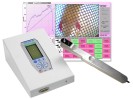Authors
Casals-Díaz L, Casas C, Navarro X
Lab
Group of Neuroplasticity and Regeneration, Institute of Neurosciences and Department of Cell Biology, Physiology and Immunology, Universitat Autònoma de Barcelona, Bellaterra, Spain
Journal
Restor Neurol Neurosci.
Abstract
PURPOSE:
The present study was conducted to determine changes in the expression of voltage-gated sodium channels (VGSCs) ?-subunits after nerve injury and their relation with development of neuropathic pain.
METHODS:
We used the crush injury model of regeneration of the sciatic nerve (Crush) and the spared nerve injury (SNI) model of neuropathic pain in the rat. Measurements of thermal and mechanical pain thresholds were performed until 3 months after injury. Real-time PCR and immunohistochemistry of VGSC ?-subunits were used to evaluate the mRNA and protein expression in the DRG.
RESULTS:
Both nerve injuries induced similar alterations in the VGSCs expression at 7 dpi, with upregulation of Nav1.3, and downregulation of Nav1.7, Nav1.8 and Nav1.9. These changes persisted until 28 days, when hyperalgesia was still present in SNI but not in Crush rats. At 90 days, mRNA expression of all analyzed ?-subunits returned to basal levels in the Crush group. However, SNI rats still showed altered expression of VGSCs, and neuropathic pain responses. Immunohistochemical staining revealed that Nav1.8 and Nav1.9 were widely expressed in IB4-positive neurons of the DRG, relevant in pain processing. The population of neurons coexpressing each ?-subunit and IB4 was also affected by the injury, more markedly after the Crush.
CONCLUSION:
Shifts in VGSCs expression occur in parallel to neuropathic pain behavior in rats early after injury, while at later times they appear to be more related to sensory nerve degeneration and regeneration processes.
BIOSEB Instruments Used:
Electronic Von Frey 4 (BIO-EVF4),Electronic Von Frey 5 with embedded camera (BIO-EVF5)

 Pain - Thermal Allodynia / Hyperalgesia
Pain - Thermal Allodynia / Hyperalgesia Pain - Spontaneous Pain - Postural Deficit
Pain - Spontaneous Pain - Postural Deficit Pain - Mechanical Allodynia / Hyperalgesia
Pain - Mechanical Allodynia / Hyperalgesia Learning/Memory - Attention - Addiction
Learning/Memory - Attention - Addiction Physiology & Respiratory Research
Physiology & Respiratory Research
 Pain
Pain Metabolism
Metabolism Motor control
Motor control Neurodegeneration
Neurodegeneration Cross-disciplinary subjects
Cross-disciplinary subjects Muscular system
Muscular system General activity
General activity Mood Disorders
Mood Disorders Other disorders
Other disorders Joints
Joints Central Nervous System (CNS)
Central Nervous System (CNS) Sensory system
Sensory system

